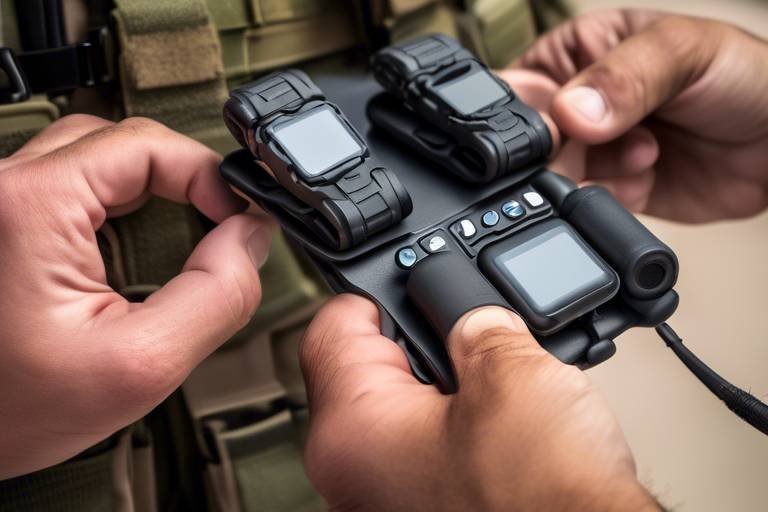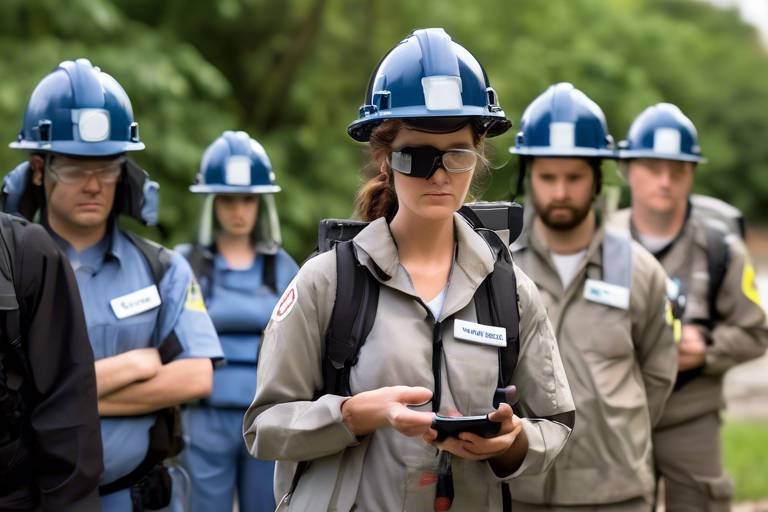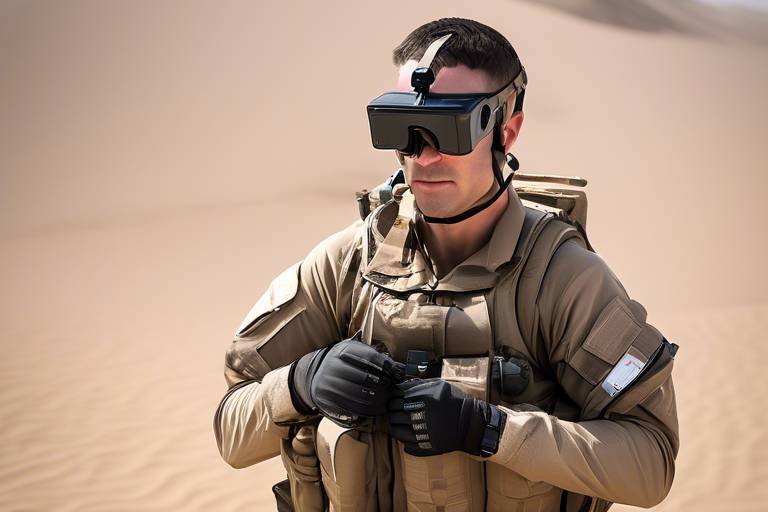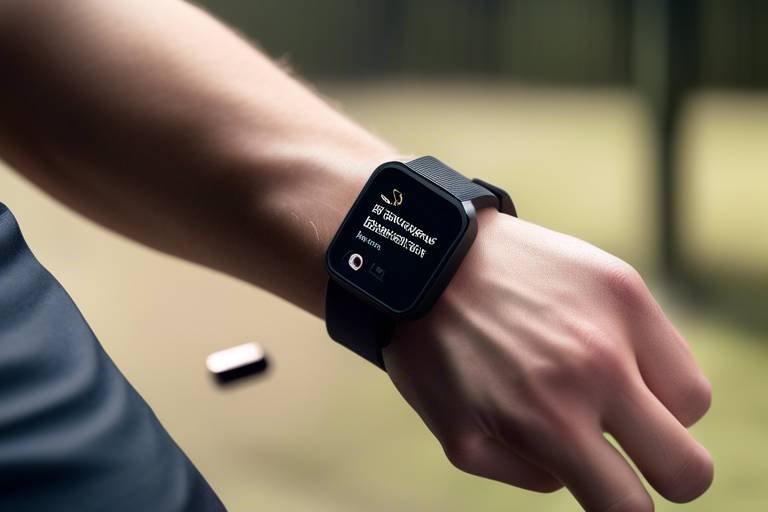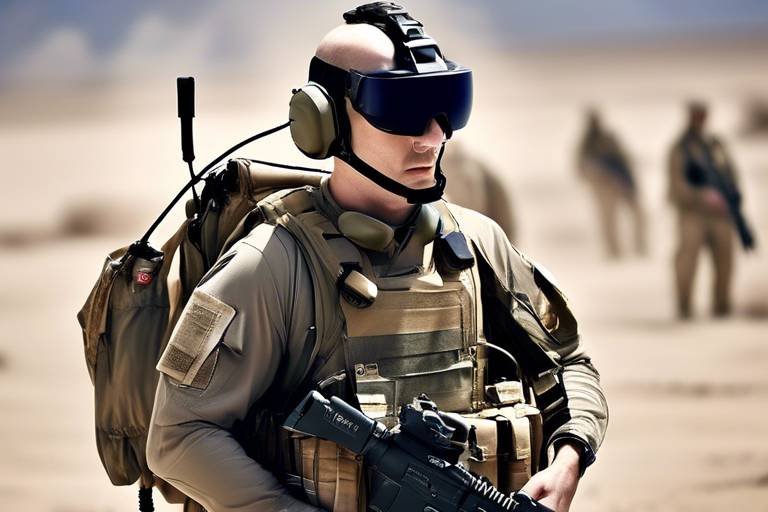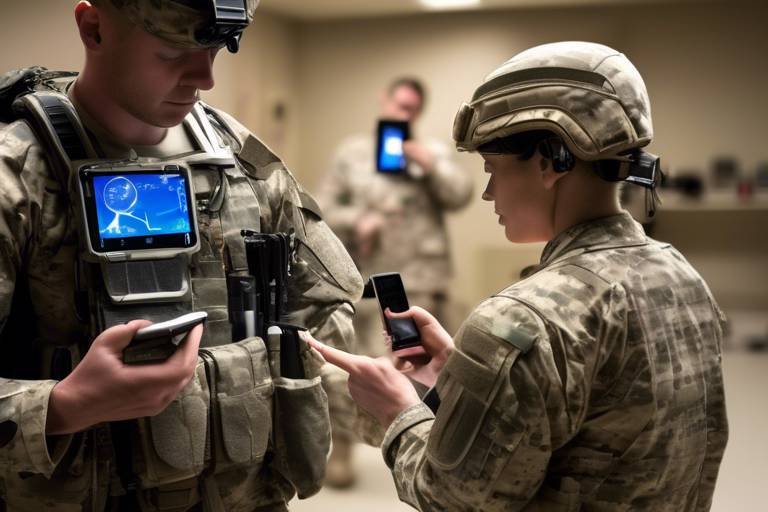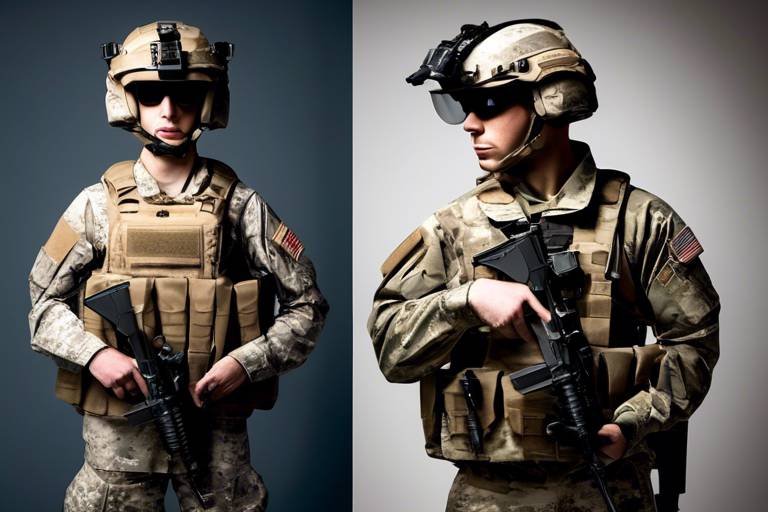How Wearables Aid in Counter-Narcotics Operations
In today's fast-paced world, the fight against drug-related crimes has become increasingly complex. Law enforcement agencies are constantly seeking innovative solutions to stay one step ahead of criminals. Enter wearable technology—a game changer in the realm of counter-narcotics operations. These cutting-edge devices not only enhance operational efficiency but also improve officer safety and situational awareness. Imagine a world where officers on the ground have access to real-time data and communication tools that can make or break an operation. Sounds intriguing, right? Let's dive deeper into how these wearables are transforming the landscape of law enforcement.
Wearable devices equipped with advanced cameras and sensors provide law enforcement with a powerful tool for real-time surveillance. Picture this: an officer in the field, wearing a camera that streams live footage back to the command center. This capability allows for better monitoring of suspected drug activities and improves situational awareness during operations. By having eyes on the ground, officers can make informed decisions quickly, adapting their strategies as situations unfold. The use of wearables ensures that no detail goes unnoticed, significantly increasing the chances of successful interventions.
One of the standout features of wearables is their ability to collect critical data on locations, movements, and interactions. This data can then be analyzed to identify patterns and inform strategic decision-making in counter-narcotics initiatives. For instance, if a particular area shows a spike in suspicious activity, law enforcement can deploy additional resources to investigate further. The insights gained from this data not only help in immediate operations but also contribute to long-term strategies aimed at dismantling drug networks. In essence, wearables turn officers into data collectors, making them more effective in their roles.
Imagine being in a high-stakes operation where every second counts. Wearable technology facilitates instant communication among team members, ensuring that information is shared swiftly and efficiently. This is crucial during operations where the situation can change in the blink of an eye. With features like push-to-talk capabilities and messaging apps integrated into wearables, officers can coordinate their actions seamlessly, reducing the risk of miscommunication. In a world where timing is everything, this level of connectivity can make all the difference.
Wearables can seamlessly integrate with existing technologies, such as drones and GPS systems. This integration enhances operational effectiveness by providing comprehensive situational insights to law enforcement. For example, a drone can be deployed to survey an area while wearables relay vital information back to the team on the ground. This collaborative approach empowers officers with a holistic view of their surroundings, allowing them to make informed decisions quickly. The synergy between wearables and other technologies is a testament to how innovation can revolutionize law enforcement.
Officer safety is paramount in any law enforcement operation, especially in counter-narcotics efforts where the risks can be high. Wearable devices equipped with health monitoring features help ensure officer safety by tracking vital signs and alerting teams in case of emergencies. For instance, if an officer's heart rate spikes unexpectedly, a notification can be sent to their team, prompting immediate assistance. This proactive approach to officer safety not only protects lives but also fosters a culture of care within law enforcement agencies.
Training is essential for any law enforcement agency, and wearables can play a pivotal role in enhancing training simulations. By offering officers hands-on experience with the technology they will use in the field, wearables ultimately increase their preparedness for real-world scenarios. Imagine a training exercise where officers practice responding to a simulated drug bust while utilizing their wearables. This immersive experience not only builds confidence but also ensures that officers are well-versed in the technology before they face real-life challenges.
Despite their numerous benefits, the integration of wearable technology in counter-narcotics operations is not without challenges. Issues such as privacy concerns, data security, and the need for appropriate training for law enforcement personnel can hinder the adoption of these devices. For instance, the collection of data raises questions about how that information will be used and stored. Ensuring that officers are trained to handle these devices effectively is also crucial, as improper use can lead to operational failures.
The financial implications of adopting wearable technology can be significant. Agencies must consider budgeting for necessary devices and infrastructure, which can be a tough sell in times of tight budgets. Justifying the costs associated with wearables requires a clear understanding of their potential return on investment in terms of enhanced operational efficiency and officer safety. However, the long-term benefits often outweigh the initial expenses, making it a worthwhile investment for many law enforcement agencies.
As technology continues to evolve at a rapid pace, law enforcement agencies must remain adaptable. This means continually updating their wearables and software to stay at the forefront of counter-narcotics strategies and tactics. Agencies that fail to embrace these advancements risk falling behind in the fight against drug-related crimes. Staying informed about the latest developments in wearable technology is essential for law enforcement to maintain their effectiveness in an ever-changing landscape.
- What types of wearables are commonly used in counter-narcotics operations? Wearables can include body cameras, health monitors, and communication devices, all designed to enhance situational awareness and officer safety.
- How do wearables improve data collection? Wearables collect real-time data on officer movements and interactions, which can be analyzed to identify patterns and inform strategic decisions.
- What are the privacy concerns associated with wearable technology? Privacy concerns revolve around data collection, storage, and the potential misuse of information gathered during operations.
- How can agencies justify the cost of wearables? Agencies can justify the cost by highlighting the potential for improved operational efficiency and enhanced officer safety, which can ultimately save lives and resources.
Enhancing Surveillance Capabilities
This article explores the significant role of wearable technology in enhancing counter-narcotics efforts, detailing various applications, benefits, and challenges faced by law enforcement agencies in their fight against drug-related crimes.
In the ever-evolving landscape of law enforcement, the integration of wearable technology has revolutionized how officers conduct surveillance during counter-narcotics operations. Imagine being able to monitor a suspected drug deal in real-time while remaining undetected. Wearable devices, equipped with advanced cameras and sensors, empower law enforcement to do just that. These devices not only capture high-definition video footage but also provide crucial data about the environment, such as temperature, humidity, and even sound levels, all of which can be vital in assessing the situation on the ground.
One of the most significant advantages of these wearables is their ability to enhance situational awareness. Officers can access live feeds and analytics directly from their devices, allowing them to make informed decisions on the fly. For instance, if a team is monitoring a known drug trafficking area, the wearables can alert them to unusual movements or activities that may indicate a drug transaction. This proactive approach can mean the difference between a successful operation and a missed opportunity.
Furthermore, the integration of GPS technology within these wearables allows for precise tracking of officers' locations during operations. This feature is especially beneficial in chaotic environments where communication can break down. By knowing exactly where each team member is located, command centers can coordinate efforts more effectively, ensuring that backup is available when needed. The ability to visualize the team's movements on a map in real-time adds an additional layer of safety and efficiency.
To illustrate the impact of wearable technology in surveillance, consider the following table that highlights key features and their benefits:
| Feature | Benefit |
|---|---|
| High-definition cameras | Capture clear evidence and monitor activities discreetly |
| Real-time data analytics | Provide immediate insights into suspicious behaviors and patterns |
| GPS tracking | Enhance officer safety by ensuring accurate location data |
| Health monitoring | Alert teams in case of medical emergencies during operations |
Moreover, the collaborative nature of these devices cannot be overlooked. Wearables can facilitate instant communication among team members, ensuring that critical information is shared swiftly. Imagine an officer in the field spotting a potential threat and being able to communicate that to the rest of the team without delay. This level of coordination is crucial in high-stakes environments where every second counts.
In conclusion, the enhancement of surveillance capabilities through wearable technology is not just a trend; it is a fundamental shift in how law enforcement approaches counter-narcotics operations. By leveraging these tools, officers can operate more efficiently, safely, and effectively, ultimately leading to a stronger fight against drug-related crimes.
- What types of wearable devices are used in counter-narcotics operations?
Devices include cameras, GPS trackers, and health monitors, each serving a unique purpose in enhancing operational efficiency and officer safety. - How does real-time data collection improve operations?
Real-time data allows officers to identify patterns and make informed decisions quickly, increasing the chances of successful interventions. - Are there privacy concerns associated with using wearables?
Yes, the use of surveillance technology raises important questions about privacy and data security that law enforcement agencies must address. - What training is required for officers to use wearables effectively?
Officers need training on how to operate the devices, interpret data, and integrate them into their existing operational protocols.
Data Collection and Analysis
In the realm of counter-narcotics operations, data collection and analysis are pivotal components that can significantly impact the effectiveness of law enforcement efforts. Wearable technology has revolutionized the way officers gather and interpret data, enabling them to make informed decisions on the fly. These devices are not just fancy gadgets; they are powerful tools that provide insights into various aspects of drug-related activities.
Imagine a scenario where officers are monitoring a suspected drug trafficking location. With wearables equipped with GPS and advanced sensors, they can collect real-time data on the movements of individuals in the area. This information is invaluable as it helps to build a comprehensive picture of the situation. For instance, by analyzing movement patterns, officers can identify hotspots—areas where drug-related activities are concentrated. This data can then be utilized to deploy resources more effectively, ensuring that law enforcement is always one step ahead.
Moreover, wearables allow officers to capture interactions and communications. This capability is crucial in understanding the dynamics of drug trafficking networks. The data collected can be analyzed to reveal connections between individuals, leading to the identification of key players within these networks. By understanding who interacts with whom, law enforcement can devise targeted strategies to dismantle these operations.
Another significant advantage of wearables is their ability to integrate with various data analysis platforms. This integration enhances the analytical capabilities of law enforcement agencies, allowing them to leverage big data techniques to uncover trends and correlations that may not be immediately evident. For example, a table summarizing the types of data collected through wearables might look like this:
| Data Type | Description | Use in Operations |
|---|---|---|
| Location Data | Real-time GPS tracking of officer movements | Identifying hotspots and monitoring suspect movements |
| Communication Logs | Records of interactions between officers and suspects | Understanding network connections within drug operations |
| Environmental Data | Information on surroundings, such as temperature and noise levels | Assessing operational risks and planning interventions |
Furthermore, the ability to analyze data in real-time means that officers can respond to emerging situations more effectively. For instance, if data indicates a sudden influx of individuals at a specific location, law enforcement can quickly mobilize additional resources to investigate further. This agility in data-driven decision-making is essential in the fast-paced world of counter-narcotics.
However, it's important to remember that while wearables offer tremendous benefits for data collection and analysis, they must be used responsibly. Issues surrounding data privacy and security must be addressed to ensure that the rights of individuals are protected. Law enforcement agencies must establish clear protocols regarding data usage and storage to maintain public trust.
In conclusion, the integration of wearables into data collection and analysis processes is transforming counter-narcotics operations. By harnessing the power of technology, law enforcement can enhance their effectiveness, improve situational awareness, and ultimately, combat drug-related crimes more efficiently. As we move forward, the continued evolution of wearable technology will undoubtedly play a crucial role in shaping the future of law enforcement.
- What types of wearables are commonly used in counter-narcotics operations?
Wearables such as body cameras, GPS trackers, and health monitoring devices are commonly employed to enhance surveillance and officer safety. - How does data collected from wearables improve decision-making?
The real-time data allows officers to identify patterns, hotspots, and key players in drug trafficking, leading to more informed and strategic operations. - What are the privacy concerns associated with wearable technology?
Privacy concerns revolve around the potential misuse of personal data and the need for transparent protocols regarding data collection and storage.
Real-Time Communication
When it comes to counter-narcotics operations, is nothing short of a game-changer. Imagine a scenario where law enforcement officers are spread out across a city, each monitoring different hotspots for drug activity. Without immediate communication, critical information could be lost, leading to missed opportunities or, worse, dangerous situations. Wearable technology, like smartwatches and body cameras, allows officers to stay connected in real-time, sharing vital information as situations unfold.
These devices often come equipped with features that enable instant messaging, voice calls, and even video feeds. For instance, an officer observing suspicious behavior can quickly alert their team through a simple voice command, ensuring that backup is on the way before the situation escalates. This level of instantaneous communication not only enhances the safety of the officers involved but also increases the likelihood of successful interventions. Think of it as a well-orchestrated symphony, where each musician (or officer) plays their part in harmony, responding to cues and signals from one another.
Moreover, the integration of wearable technology with mobile applications allows for seamless data sharing. Officers can send images, location data, and even live video feeds directly to their command center, providing real-time updates that are crucial for decision-making. This capability can significantly improve the effectiveness of operations, as commanders can assess the situation and deploy resources accordingly. A well-informed team is a powerful team, and with wearables, law enforcement agencies can ensure that everyone is on the same page.
However, it's essential to recognize that while these technologies offer tremendous benefits, they also require robust training to maximize their potential. Officers must be well-versed in using these devices under pressure, ensuring that they can maintain effective communication even in the heat of the moment. As wearables continue to evolve, ongoing training will be necessary to keep pace with new features and functionalities, ultimately leading to a more prepared and responsive law enforcement community.
In summary, the introduction of wearable technology into counter-narcotics operations has revolutionized the way officers communicate. With the ability to share information instantly and effectively, these devices not only enhance operational efficiency but also significantly improve officer safety. As we continue to explore the potential of wearables, the future of law enforcement looks increasingly promising.
- How do wearables improve communication among law enforcement officers?
Wearables allow for instant messaging, voice calls, and video feeds, enabling officers to share critical information in real-time, which is essential during operations. - What training is required for officers to use wearable technology effectively?
Officers need comprehensive training on the features and functionalities of the devices, focusing on how to use them under pressure to maintain effective communication. - Are there any privacy concerns associated with the use of wearables in law enforcement?
Yes, privacy concerns can arise, especially regarding the data collected and how it is stored and used. Agencies must implement strict protocols to protect sensitive information.
Integration with Other Technologies
In today's fast-paced world, the integration of wearable technology with other advanced systems is revolutionizing the way law enforcement agencies conduct counter-narcotics operations. Imagine a scenario where a team of officers is on the ground, equipped with smart glasses that not only provide real-time data but also sync seamlessly with drones hovering above. This synergy between wearables and other technologies creates a powerful operational advantage, allowing for comprehensive situational awareness and strategic planning.
Wearable devices can connect with various technologies, such as GPS systems and body cameras, enabling officers to track their locations and movements with pinpoint accuracy. For instance, when an officer responds to a suspected drug deal, their wearable device can automatically relay their coordinates to a command center. This information can be displayed on a live map, allowing supervisors to monitor the operation in real time and coordinate support if necessary.
Moreover, the integration of wearables with data analytics platforms enhances the ability to analyze patterns in drug-related activities. By collecting and sharing data from multiple sources—such as drones capturing aerial footage and wearables recording officer interactions—law enforcement can identify hotspots for drug trafficking and allocate resources more effectively. This data-driven approach increases the chances of successful interventions and arrests.
However, it’s not just about tracking and surveillance; the integration of wearables with communication tools is equally crucial. Imagine officers in the field receiving real-time updates about their surroundings or alerts about potential threats directly through their wearable devices. This instant communication can dramatically improve response times and decision-making during high-pressure situations. For example, if an officer spots suspicious behavior, they can alert their team immediately, ensuring everyone is on the same page and ready to act.
In summary, the integration of wearable technology with other advanced systems is a game-changer for counter-narcotics operations. By enhancing situational awareness, improving communication, and enabling data-driven decision-making, these technologies empower law enforcement agencies to tackle drug-related crimes more effectively than ever before.
- What types of wearable technology are used in counter-narcotics operations?
Wearable technology includes smart glasses, body cameras, GPS trackers, and health monitoring devices.
- How does wearable technology improve officer safety?
Wearables can monitor vital signs and send alerts in emergencies, ensuring quick responses to potential dangers.
- What are the challenges of integrating wearables with existing technologies?
Challenges include data security, privacy concerns, and the need for proper training for law enforcement personnel.
Improving Officer Safety
When it comes to counter-narcotics operations, officer safety is paramount. The unpredictable nature of drug-related activities can put law enforcement personnel in precarious situations. This is where wearable technology truly shines. Imagine a scenario where officers are deep undercover or in a high-risk area; having devices that monitor their vital signs can be a game changer. These wearables can track heart rates, body temperature, and even stress levels, providing crucial data that can alert teams if an officer is in distress.
Furthermore, these devices can be integrated with communication systems to send out immediate alerts if an officer's health metrics indicate a potential emergency. For instance, if an officer's heart rate spikes beyond a certain threshold, the wearable could automatically notify their team, allowing for a swift response. This capability not only enhances the safety of individual officers but also fosters a culture of vigilance and support among the entire team.
In addition to health monitoring, wearables can also include GPS tracking features. This is particularly important in complex urban environments where officers may find themselves isolated during operations. By utilizing real-time location tracking, command centers can monitor officer movements and provide assistance if they stray into dangerous areas. This technology acts like a lifeline, ensuring that help is just a click away.
Moreover, the data collected from these devices can be invaluable for future training and operational planning. By analyzing past incidents where officers faced health emergencies, law enforcement agencies can develop better strategies to mitigate risks in the field. This continuous feedback loop not only improves safety protocols but also enhances overall operational effectiveness.
In conclusion, the integration of wearable technology in law enforcement is not just about enhancing operational efficiency; it's fundamentally about protecting lives. As technology continues to evolve, the potential for these devices to improve officer safety will only grow, ensuring that those who serve and protect are equipped with the best tools available.
- What types of wearables are used in law enforcement? Wearables can include smartwatches, body cameras, health monitoring devices, and GPS trackers.
- How do wearables improve communication during operations? They enable instant communication among team members, allowing for swift information sharing in critical situations.
- Are there privacy concerns with using wearables? Yes, privacy concerns can arise, especially regarding data collection and monitoring of officers.
- What are the costs associated with implementing wearable technology? Costs can vary widely depending on the type of devices and infrastructure required, necessitating careful budgeting.
- How can training be improved with wearables? Wearables can be used in training simulations to provide officers with hands-on experience, enhancing their preparedness for real-world scenarios.
Training and Preparedness
In the ever-evolving landscape of law enforcement, are not just buzzwords; they are the backbone of effective counter-narcotics operations. With the integration of wearable technology, officers can engage in realistic training simulations that mirror the challenges they will face in the field. Imagine a scenario where an officer is equipped with a wearable device that tracks their movements, captures real-time data, and even simulates emergency situations. This not only enhances their skill set but also builds confidence.
Wearables can be used in various training exercises to teach officers how to utilize technology effectively during operations. For instance, officers can practice using wearable cameras to document evidence while on a simulated drug bust. This hands-on experience is invaluable, as it allows them to familiarize themselves with the technology in a controlled environment before facing real-world situations. The result? Officers are better prepared, more efficient, and less likely to make critical mistakes when the stakes are high.
Moreover, training programs can be customized to address specific challenges faced in counter-narcotics efforts. For example, a training module could focus on the use of wearables in urban environments, where navigating through crowds and tight spaces is essential. By incorporating scenario-based training, law enforcement agencies can ensure that their personnel are not just users of technology but masters of it.
Another significant benefit of using wearables in training is the ability to collect and analyze performance data. This data can be used to assess how well officers are adapting to new technologies and identify areas that need improvement. By analyzing metrics such as reaction times, decision-making processes, and even physiological responses during high-pressure scenarios, trainers can provide targeted feedback to enhance officer performance.
In summary, the integration of wearable technology into training programs is a game-changer for law enforcement agencies. It not only prepares officers for the realities of counter-narcotics operations but also fosters a culture of continuous learning and adaptation. As technology advances, so too must the strategies used to train those on the front lines of the fight against drug-related crimes.
- What types of wearables are used in counter-narcotics operations?
Wearables can include smart glasses, body cameras, health monitors, and GPS tracking devices, each serving a unique purpose in enhancing operational efficiency.
- How do wearables improve officer safety?
Wearable devices can monitor vital signs and send alerts during emergencies, providing real-time health data that can be crucial in dangerous situations.
- Are there privacy concerns with using wearable technology?
Yes, the use of wearables raises significant privacy issues, particularly regarding the collection and storage of personal data. Agencies must implement strict protocols to protect this information.
- How can agencies budget for wearable technology?
Agencies should conduct a thorough cost-benefit analysis and consider long-term savings associated with increased efficiency and officer safety when seeking funding for wearable technology.
Challenges in Implementation
While the integration of wearable technology in counter-narcotics operations presents numerous advantages, it is not without its challenges. One of the primary concerns is privacy. The use of devices that can record audio and video raises significant questions about the rights of individuals being monitored. Law enforcement agencies must navigate the delicate balance between effective surveillance and respecting the privacy of citizens. This often leads to heated debates about the ethical implications of using such technology in public spaces.
Another major hurdle is data security. With the collection of sensitive information comes the responsibility to protect it from unauthorized access. Cybersecurity threats are ever-present, and law enforcement agencies must ensure that the data collected through wearables is stored securely and transmitted safely. This requires robust encryption methods and regular updates to security protocols to fend off potential breaches.
Moreover, the successful implementation of wearable technology hinges on the training of personnel. Officers must be adequately trained not only to use the devices but also to understand the data they collect. Without proper training, the potential of wearables could be significantly diminished. Agencies need to invest time and resources into developing comprehensive training programs that cover both technical skills and ethical considerations.
Cost is also a significant factor in the adoption of wearable technology. The financial implications can be daunting. Agencies may need to budget for not only the devices themselves but also the necessary infrastructure to support their use. This includes software for data analysis and secure storage solutions. The justification for these expenses can be challenging, especially in times of budget constraints.
Finally, as technology evolves, law enforcement agencies face the challenge of adapting to new advancements. The rapid pace of technological change means that agencies must remain vigilant and proactive in updating their systems and training. This continual evolution can be resource-intensive, requiring ongoing investment and commitment.
In summary, while wearable technology holds great promise for enhancing counter-narcotics operations, it is essential for law enforcement agencies to address these challenges head-on. By doing so, they can leverage the full potential of wearables to combat drug-related crimes effectively.
- What are the main benefits of using wearables in counter-narcotics operations? Wearables enhance surveillance capabilities, improve officer safety, and facilitate real-time communication among team members.
- How do privacy concerns affect the use of wearable technology? The ability to record audio and video can infringe on individuals' rights, necessitating careful consideration of ethical implications.
- What training is required for officers using wearable devices? Officers need training on both the technical aspects of the devices and the analysis of the data collected to maximize their effectiveness.
- What are the cost considerations for implementing wearable technology? Agencies must budget for devices, data analysis software, and secure storage solutions, which can be significant financial commitments.
- How can law enforcement agencies keep up with technological advancements? Agencies need to invest in ongoing training and updates to their systems to adapt to new technologies effectively.
Cost Considerations
When it comes to integrating wearable technology into counter-narcotics operations, one of the most pressing issues is the cost. While the benefits of wearables are clear, the financial implications can be daunting for law enforcement agencies. These costs can be broken down into several categories, including initial investment, ongoing maintenance, and potential upgrades.
The initial investment for wearable devices can vary widely depending on the technology used. For instance, basic body cameras may cost a few hundred dollars each, while advanced wearables with health monitoring and real-time data transmission capabilities can run into the thousands. Additionally, agencies need to consider the cost of infrastructure to support these devices, such as data storage solutions and software systems.
Ongoing maintenance is another critical factor. Wearable devices require regular updates and repairs, which can add up over time. Furthermore, agencies must allocate funds for training personnel to use these technologies effectively. Without proper training, the potential of wearables can be severely limited, leading to wasted resources.
To give you a clearer picture, here’s a simple table that illustrates some of the potential costs involved:
| Cost Category | Estimated Cost |
|---|---|
| Initial Purchase of Wearables | $500 - $5,000 per device |
| Data Storage and Management | $1,000 - $10,000 annually |
| Training Programs | $2,000 - $20,000 per session |
| Maintenance and Repairs | $500 - $2,500 annually |
Moreover, as technology evolves, law enforcement agencies must also budget for potential upgrades. Newer models with enhanced features are frequently released, and staying up-to-date can be crucial for maintaining operational effectiveness. This ongoing need for adaptation can strain already tight budgets.
In conclusion, while the integration of wearable technology in counter-narcotics operations holds great promise, law enforcement agencies must carefully navigate the financial landscape. By understanding the various costs involved and planning accordingly, they can make informed decisions that maximize the benefits of these cutting-edge tools while ensuring the safety and effectiveness of their operations.
- What are the primary benefits of using wearables in counter-narcotics operations? Wearables enhance surveillance capabilities, improve officer safety, and facilitate real-time communication among team members.
- How can law enforcement agencies fund the purchase of wearable technology? Agencies can seek grants, allocate budget funds, or collaborate with private sector partners to secure necessary funding.
- What challenges do agencies face when implementing wearable technology? Challenges include costs, privacy concerns, data security, and the need for adequate training for personnel.
- Are there any privacy concerns associated with wearable technology? Yes, the use of wearables can raise privacy issues, particularly regarding the collection and storage of personal data during operations.
Adapting to Technological Advances
As technology continues to evolve at a breakneck pace, law enforcement agencies find themselves in a constant race to keep up. The introduction of wearable technology in counter-narcotics operations is no exception. These devices not only enhance operational capabilities but also require agencies to adapt to new advancements to maximize their effectiveness. It's like trying to catch a train that’s always moving—if you’re not on board, you’ll be left behind.
One of the primary challenges is ensuring that officers are trained on the latest features and functionalities of these wearables. For instance, imagine an officer equipped with a cutting-edge device that can track heart rates, monitor environmental conditions, and provide real-time data analytics. If that officer isn't familiar with how to operate the device, all that technology becomes useless. Therefore, ongoing training programs must be established to keep personnel updated on the latest advancements.
Moreover, as new wearables hit the market, law enforcement agencies must evaluate their cost-effectiveness and practicality. This means conducting thorough assessments to determine which devices will provide the most benefit in the field. The decision-making process can be daunting, especially when considering the budget constraints that many departments face. To illustrate this, here’s a simple table comparing the costs and benefits of various wearable technologies:
| Device Type | Estimated Cost | Primary Benefits |
|---|---|---|
| Body Cameras | $500 - $1,500 | Real-time video evidence, accountability |
| Health Monitors | $100 - $300 | Vital signs tracking, emergency alerts |
| Smart Glasses | $1,000 - $2,500 | Augmented reality support, hands-free operation |
In addition to the financial aspect, agencies must also focus on the integration of these wearables with existing systems. This means that as new technologies are adopted, they should seamlessly work with current databases, communication systems, and operational protocols. For example, if a wearable device captures critical data during a raid, it should automatically sync with the agency’s central database to ensure that all information is readily accessible for analysis.
Furthermore, the rapid pace of technological change means that law enforcement must remain flexible and adaptable. This can involve not only adopting new devices but also being open to changing tactics based on what the technology reveals. It’s akin to a dancer who must adjust their steps in response to the music’s tempo—staying in sync is crucial for success.
Ultimately, adapting to technological advances is not just about keeping up; it’s about leveraging these innovations to enhance the effectiveness of counter-narcotics operations. By investing in training, evaluating costs, ensuring integration, and remaining flexible, law enforcement agencies can turn the challenge of adaptation into an opportunity for improvement. This proactive approach can significantly impact the fight against drug-related crimes, making every operation more efficient and effective.
- What are the main benefits of using wearable technology in law enforcement?
Wearable technology provides enhanced surveillance, real-time data collection, improved officer safety, and better communication among team members. - How does wearable technology improve officer safety?
Devices equipped with health monitoring features can track vital signs and alert teams in case of emergencies, ensuring officers' well-being during operations. - What challenges do law enforcement agencies face when implementing wearables?
Challenges include privacy concerns, data security issues, cost considerations, and the need for continuous training and adaptation to new technologies.
Frequently Asked Questions
- How do wearables enhance surveillance capabilities in counter-narcotics operations?
Wearable devices equipped with advanced cameras and sensors provide law enforcement with real-time surveillance. This allows officers to monitor suspected drug activities more effectively, improving their situational awareness during operations. Imagine having an extra set of eyes that can capture crucial details while keeping officers safe and discreet.
- What types of data can wearables collect for analysis?
Wearables can gather a variety of critical data, including locations, movements, and interactions. This data can be analyzed to identify patterns in drug-related activities, helping agencies make informed strategic decisions. Think of it as piecing together a puzzle that reveals the bigger picture of drug operations.
- How does wearable technology facilitate real-time communication among officers?
Wearable technology allows for instant communication among team members, ensuring that vital information is shared swiftly and efficiently. In high-stakes operations, this can be the difference between success and failure, much like a well-coordinated dance where every step counts.
- Can wearables integrate with other technologies?
Absolutely! Wearables can seamlessly integrate with existing technologies such as drones and GPS systems. This integration enhances operational effectiveness by providing comprehensive situational insights, allowing law enforcement to respond more effectively to evolving situations.
- What safety features do wearables offer to officers?
Wearable devices often come equipped with health monitoring features that track vital signs. In case of emergencies during potentially dangerous operations, these devices can alert teams, ensuring that officer safety is prioritized. It's like having a personal health assistant on the job!
- How can wearables be used in training for law enforcement?
Wearables can be utilized in training simulations, providing officers with hands-on experience with the technology they will use in the field. This increases their preparedness for real-world scenarios, much like a pilot training on a flight simulator before taking to the skies.
- What challenges do law enforcement agencies face when implementing wearables?
Despite their benefits, integrating wearable technology presents challenges such as privacy concerns, data security issues, and the need for appropriate training for personnel. Agencies must navigate these hurdles to ensure effective use of the technology.
- Are there significant costs associated with adopting wearable technology?
Yes, the financial implications of adopting wearable technology can be considerable. Agencies need to carefully budget and justify expenses to secure funding for necessary devices and infrastructure. It's like investing in a high-tech tool that can yield significant returns in operational efficiency.
- How do law enforcement agencies keep up with technological advances in wearables?
As technology evolves, law enforcement agencies must continually adapt to new wearables and software. This ensures they remain at the forefront of counter-narcotics strategies and tactics, much like staying ahead in a race where the finish line keeps moving.

